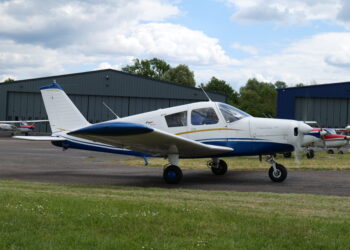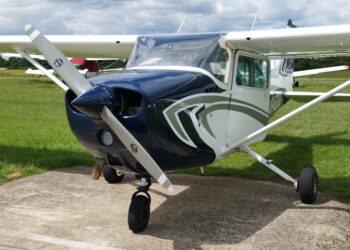Private Pilots Licence Course
Learning to fly is a dream that many people have from a young age, with Azure Flight Training Centre we can help make that dream become a reality. Gaining your Private Pilot’s Licence will be one of the most rewarding activates you will ever undertake. It not only requires finances for the training but also dedication, hard work and a serious commitment to be able to pass all 9 theory exams and two practical tests.
We make sure that all our students and members receive the maximum level of support and tuition from our instructors. We train from two airports in the UK, one at Cranfield and the other at Elstree with access to seven aircraft.
The CAA (Civil Aviation Authority) Private Pilots Licence requires a minimum of 45 hours flight training. This consists of a minimum of 25 hours dual instruction, minimum 10 hours solo flying, 5 hours of solo cross country of which one must consist of 150nm with two full stop landings at two different airports.
PPL Study Books

PPL Exams
- Air Law
- Human Performance
- Meteorology
- Communications
- Principles of Flight
- Flight Performance and Planning
- Operational Procedures
- Aircraft General
- Navigation
- Radio Telephony Licence (Practical Test)
- Flight Skills Test (Practical Test)
Examination Assessment
Before you can dazzle the skies with your pilot prowess in the skills test, there’s some ground work to cover. You’ve got to tackle those ground examinations with as much gusto as a plane on takeoff, and don’t forget about the practical RT (Radio Telephony) exam—it’s your ticket to smooth communication in the air.
But here’s the catch: you’ll need to score a minimum of 75% on each exam to soar through with a pass. Think of it as navigating through some turbulent skies before reaching the clear blue yonder of pilot glory!
Aviation Law
This exam consists of 16 multiple choice questions to be answered in 35 minutes.
Aircraft General
This exam consists of 16 multiple choice questions to be answered in 35 minutes.
Human Performance
This exam consists of 12 multiple choice questions to be answered in 25 minutes.
Navigation
This exam consists of 12 multiple choice questions to be answered in 45 minutes.
Communications
This exam consists of 12 multiple choice questions to be answered in 20 minutes.
Flight Performance
This exam consists of 12 multiple choice questions to be answered in 45 minutes.
Principles of Flight
This exam consists of 12 multiple choice questions to be answered in 35 minutes.
Operational Procedures
This exam consists of 12 multiple choice questions to be answered in 30 minutes.
Meteorology
This exam consists of 16 multiple choice questions to be answered in 50 minutes.
The PPL Skills Test
General Information
The Private Pilot Licence (PPL) does not expire unless it has been provisionally suspended, revoked, or surrendered by the hold to the CAA.
You must comply with the rules of the licence which require you to have:
- Valid medical certificate (Class 1 or 2)
- Aircraft Ratings must be valid (SEP)
Course Requirements (Minimum's)
You will need to fly at least 40 hours of instructional flights on our aircraft, which must include the following:
- Minimum 25 hours dual flight instruction
- Minimum 10 hours supervised solo flight time
- Minimum 5 hours of solo cross country flying
- 1 cross-country flight of at least 270 km (150 NM), during which full stop landings at 2 aerodromes different from the aerodrome of departure shall be made
Medical Permit
You must obtain an appropriate medical certificate at least before your first solo, but we strongly recommend getting a medical before commencement of your training.
You must study the following theoretical subjets and pass a test with at least 75%:
- Air Law
- Human Performance
- Meteorology
- Communications
- Operational Procedures
- Principles of Flight
- Flight Performance and Planning
- Aircraft General Knowledge
- Navigation
Before Skills Test
Before being put forward for your skills test by the Head of Training, you will need to have completed the following:
- You must have achieved at least 75% of the marks allocated to each of the required examination papers and importantly passed them all within 18 months from end of the calendar month of your first exam.
- Completed all flight training
- Completed RT Test
- Have a valid medical
PPL (A) Skills Test
Before you take the skill test, you must have passed the required theoretical knowledge examinations.
The theoretical knowledge instruction shall always have been completed before the skill tests are taken.
We will then recommend you for the skills test by our Head of Training once the training is completed. At which point your training records will be made available to the examiner. The PPL(A) skill test schedule is given below
Note: Use of checklist, airmanship, control of aeroplane by external visual reference, anti/de-icing procedures, etc. apply in all section tabs
Pre-Flight Operations and Departure
- Pre-flight documentation, NOTAM and weather briefing
- Mass and balance and performance calculation
- Aeroplane inspection and servicing
- Engine starting and after starting procedures
- Taxiing and aerodrome procedures, pre-take-off procedures
- Take-off and after take-off checks
- Aerodrome departure procedures
- ATC compliance and R/T procedures
General Airwork
- ATC compliance and R/T procedures
- Straight and level flight, with speed changes
- Climbing:
- (i) best rate of climb
- (ii) climbing turns
- (iii) levelling off
- Medium (30° bank) turns
- Steep (45° bank) turns (including recognition and recovery from a spiral dive)
- Flight at critically low air speed with and without flaps
- Stalling:
- (i) clean stall and recover with power
- (ii) approach to stall descending turn with bank angle 20°, approach configuration
- (iii) approach to stall in landing configuration
- Descending:
- (i) with and without power
- (ii) descending turns (steep gliding turns)
- (iii) levelling off
En-Route Procedures
- Flight plan, dead reckoning and map reading
- Maintenance of altitude, heading and speed
- Orientation, timing and revision of ETAs and log keeping
- Diversion to alternate aerodrome (planning and implementation)
- Use of radio navigation aids
- Basic instrument flying check (180° turn in simulated IMC)
- Flight management (checks, fuel systems and carburettor icing, etc)
- ATC compliance and R/T procedures
Approach and Landing Procedures
- Aerodrome arrival procedures
- Precision landing (short field landing), crosswind, if suitable conditions available
- Flapless landing
- Approach to landing with idle power (SE only)
- Touch and go
- Go-around from low height
- ATC compliance and R/T procedures
- Actions after flight
These items may be combined at the discretion of the examiner
Abnormal and Emergency Procedures
This section may be combined with sections 1 through 4
- Simulated engine failure after take-off (SE only)
- Simulated forced landing (SE only)
- Simulated precautionary landing (SE only)
- Simulated emergencies
- Oral questions
These items may be combined at the discretion of the examiner
Simulated Asymmetric Flight and Relevant Class or Type Items
- Simulated engine failure during take-off (at a safe altitude, unless carried out in an FFS)
- Asymmetric approach and go-around
- Asymmetric approach and full stop landing
- Engine shutdown and restart
- ATC compliance, R/T procedures or airmanship
- As determined by the FE: any relevant items of the class or type rating skilltest to include, if applicable:
- (i) aeroplane systems including handling of auto pilot
- (ii) operation of pressurisation system
- (iii) use of de-icing and anti-icing system
- Oral questions
This section may be combined with sections 1 through 5
Our Aircrafts to Teach PPL

G-ATHR Piper PA28 Cherokee 180
Piper PA28 Cherokee 180

G-BTNT Piper PA28 Warrior 160
Piper PA28 Warrior 160

G-CLLR Piper PA28 Cherokee 140
Piper PA28 Cherokee 140

G-GZDO Cessna 172N Skyhawk
Cessna 172N Skyhawk

G-ENTW REIMS Cessna F152 C152
Cessna F152 C152

G-AWFJ Piper PA28R 180 Arrow
Piper PA28R 180 Arrow
Frequently Asked Questions
Currently we only provide UK CAA PPL Course although we are looking at offering of UK and EASA in the future.
You must be at least 14 years old before you can start the PPL course. You must be at least 16 years old to fly solo and 17 years old to take your Skills Test.
You get 18 months to complete all nine exams from the time you pass your first exam.
It is up to you what order you take the exams, but you will need to pass the Air Law exam before going solo and Navigation exam before going solo Nav.
You will take your exams either at Cranfield or Elstree at one of our Training Centres.
Yes, once you have passed all nine of your exams you will get a further two years to complete your PPL Skills test. If you go over the two years you will need to retake all of your ground exams.
Once you have successfully passed your skills test and been issued your licence, you CAA UK Licence is valid for life. Although you will need to have a check out with a certified flight instructor every 24 month’s.
FCL.055 Language proficiency states an aeroplane, helicopter, powered-lift and airship pilots required to use the radio telephone shall not exercise the privileges of their licences and ratings unless they have a language proficiency endorsement on their licence in either English or the language used for radio communications involved in the flight. The Operational Level (Level 4) is the minimum required proficiency level for radiotelephony communication


